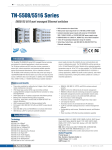Download DynaColor QIG-510 Series Installation guide
Transcript
VPort 364A Series Quick Installation Guide Moxa Industrial Video Encoder First Edition, November 2011 2011 Moxa Inc. All rights reserved. P/N: 1802003640020 Overview The VPort 364A is a 4-channel industrial video encoder that supports the H.264 video compression algorithm, which provides the best video quality on the market while requiring less bandwidth compared to other video compression standards. In addition, the VPort 364A supports simultaneous dual video streams with different formats: H.264 and MJPEG. The two video streams can be used for different purposes, such as viewing, recording, or analysis. In addition, the rugged industrial design with -40 to 75°C operating temperature, built-in fiber Ethernet ports, IP30-rated form factor, and industrial certifications, make the VPort 364A highly suitable for use in harsh environments. Package Checklist The VPort 364A ships with the following items: • • • • • • • VPort 364A. Two 5-pin terminal blocks for 2 power inputs and 2 relay outputs. 8-pin terminal block for 4 DIs (Digital Inputs). 5-pin terminal block for the RS-232/422/RS-485 PTZ control port. Quick installation guide. Documentation & Software CD Warranty Card. Note: If any of these items are missing or damaged, please contact your customer service representative for assistance. NOTE This product must be installed in compliance with your local laws and regulations. Features High Performance Audio-Video Networking Solution • • Compatible with NTSC/PAL analog video cameras H.264 and MJPEG video compression standards • Dual simultaneous video streams (1 H.264 and 1 MJPEG) • • Lower latency, under 200 ms 4 BNC video inputs • Single video stream up to 30 frames/sec in Full D1 (720 x 480) resolution in NTSC, and 25 frames/ sec in Full D1 (720 x 576) resolution in PAL • Select between Full D1/ 4CIF/ VGA/ CIF/ QCIF resolutions • • 1 audio input and 1 audio output for 2-way voice communication TCP, UDP, and HTTP network transmission modes • Modbus/TCP for easy communication with SCADA systems • Standard RTSP (Real-time streaming protocol) for easy integration • • DynaStream™ for automatic frame rate adjustment to control IP video traffic Multicast (IGMP) protocols for efficient network transmission • • QoS (TOS) for priority transmission SNMP V1/V2c/V3 for network management • Built-in web server and RS-232 console for remote access and configuration -2- • One auto-sensing 10/100BaseT(X) or 100BaseFX (SC connector) Ethernet port • 8 output video streams and 8 client connections • 50 multicast clients for receiving multicast video streams • • Multicast push for all the clients Video quality in CBR (constant bit rate) or VBR (variable bit rate) • Supports one RS-232/RS-422/RS-485 5-pin PTZ port for controlling a PTZ (PAN/TILT/ZOOM) motorized camera via a TCP/IP network UPnP and IP filtering • Rugged Industrial Design • • • • • Two 12/24 VDC and 24 VAC redundant power inputs with LED indicators -40 to 75°C operating temperature for harsh industrial environments (“T” models) 35 mm DIN-Rail mounting or panel mounting installation (with optional accessory) IP30-rated form factor CE, FCC, and UL508(pending) Intelligent Alarm Trigger Capability • • • • • • • Supports system alarms, including power failure and network link Supports event alarms, including video motion detection (VMD), video loss, digital input, and CGI event Equipped with 4 DIs and 2 relays (DO) for external sensors and alarms. Pre, trigger, and post alarm snapshot images provided. Supports sequential snapshot images Messages with snapshot images can be sent via FTP and email. Capable of setting an alarm schedule Video Management and Control • • Free Moxa VPort SDK Plus (software development kits) supported with flexible interface and sample codes for customized application or system integration. Moxa SoftNVR-IA IP surveillance software supported for the video recording and management solution. NOTE If you are interested in the VPort SDK PLUS, visit Moxa’s website (www.moxa.com) to download the software, or contact a Moxa sales representative for more information. NOTE If you are interested in SoftNVR-IA IP surveillance software, visit Moxa’s website (www.moxa.com) to download the trial version. -3- VPort 364A Panel Layout 1. 2. 3. 4. 5. 6. 7. 8. 9. 10. 11. 12. 13. 14. 15. 16. 17. 18. RS-232 console port Hardware reset button 8-pin terminal block for DI 1 to DI 4 5-pin terminal block for Relay 2 and power input 2 (PWR2) Grounding screw 5-pin terminal block for Relay 1 and power input 2 (PWR1) Heat dissipation orifices LEDs for STAT, PWR1, PWR2, and FAULT LEDs for V1 to V4 AUDIO OUTPUT port for external speakers AUDIO INPUT port for mic-in and line-in connection 4 BNC connector for V1 to V4 video inputs RJ45 10/100BaseTX Ethernet port with 10/100 Mbps LED 100BaseFX fiber optic port with 100 Mbps LED RS-232/422/485 PTZ port with 5-pin terminal block for PTZ camera control Model name Screw hole for wall mounting Screw hole for DIN-Rail mounting -4- First-Time Installation and Configuration Before installing the VPort 364A, check to make sure that all the items in the package checklist are in the box. In addition, you will need access to a notebook computer or PC equipped with an Ethernet port. Step 1: Select the Power Source The VPort 364A can be powered by a DC power input from 12 to 32 VDC, or an AC power input from 18 to 30 VAC. Two power inputs are provided for redundancy. Users can check the LED status located in the front panel to see if the power inputs are connected appropriately. If one of the power inputs fails, the FAULT LED will light up in red if the power failure alarm is enabled. NOTE The VPort 364A series supports power input specifications of 12-32 VDC for 12/24 VDC power input, or 18-30 VAC for 24 VAC power input (note that this is different from Moxa EDS switch’s 12-45 VDC power input). Step 2: Connect the VPort 364A to a Network The VPort 364A has one auto-sensing 10/100 Mbps RJ45 Ethernet or 100 Mbps fiber optic port (multi mode or single mode). An LED indicator located on the side of each port indicates a 10 Mbps or 100 Mbps Ethernet connection. Step 3: Connect the VPort 364A to cameras and an audio source The VPort 364A has four VIDEO INPUT ports (V1, V2, V3, and V4). Use the BNC connector (1.0 Vpp, 75Ω) and coaxial cable to connect video cameras to the VPort to input analog video signals. The VPort 364A has one audio input and one audio output. A microphone or an amplifier can be plugged directly into the AUDIO INPUT port, and a speaker can be plugged into the AUDIO OUTPUT port. NOTE The four LEDs (V1, V2, V3, and V4) located on the VPort 364A’s front panel indicate the video signal transmission status for video inputs. You may refer to these LEDs to verify video signal status. ATTENTION A ground loop isolator is recommended to be used between the camera and the VPort to avoid a sudden current, which is generated by the electric potential difference between these two device’s ground power, to burn out the VPort’s chips and boards. Step 4: Connecting motorized PTZ cameras and serial devices The VPort 364A has an RS-232/422/485 PTZ port with 5-pin terminal block connector. It can be used for connecting PTZ control cables for controlling PTZ cameras over the TCP/IP network. To enable PTZ control, users should configure the PTZ control protocol in the web-based manager (web console). -5- NOTE The PTZ control protocol is not standardized. To use a particular PTZ control protocol, the video server must support the driver for that protocol. Currently, the VPort 364A supports PTZ control protocol drivers for: 1. Pelco D 2. Pelco P 3. DynaColor DynaDome 4. Cohu If you need to use a protocol that is not on the list, contact the manufacturer of the camera to get the PTZ control commands, and then program its PTZ control using the VPort 364A’s Custom Camera function. NOTE The VPort 364A comes with a PTZ driver upload function for implementing new PTZ drivers. Please contact a Moxa sales representative if you need assistance from Moxa’s R&D department to create a new PTZ driver. NOTE The “Transparent PTZ Control” function in the camera driver list is used to transmit the PTZ control signal over a TCP/IP network to the VPort D361 video decoder or PC (additional driver required). The PTZ control panel or keyboard can directly control the PTZ camera or device, eliminating the need for a PTZ camera driver and allowing the use of PTZ cameras with the VPort encoder. Step 5: Configure the VPort 364A’s IP address After powering on the VPort 364A, wait a few seconds for the POST (Power On Self Test) to run. The STAT LED turns green to indicate that the POST process has completed. The IP address will be assigned when the 10/100 Mbps NETWORK LED blinks. The IP address assigned after the POST is completed depends on the network environment. Network Environment with DHCP Server In this case, the IP address of the VPort 364A is assigned by a DHCP Server. Use the DHCP Server’s IP address table, or use the Moxa utility to determine the IP address that was assigned by the DHCP Server. NOTE After powering on the VPort 364A, wait a few seconds for the POST (Power On Self Test) to run. The IP address will be assigned when the 10/100 Mbps NETWORK LED blinks. Using the Moxa VPort and EtherDevice Configurator Utility (edscfgui.exe) 1. Run the edscfgui.exe program to search for the VPort IP video products and EDS switches. After the Utility window opens, select or click on Broadcast Search, which is located under the List Server menu, to initiate a search (note that you can also click on Broadcast Search NOTE icon to initiate a search). You may download the VPort and EtherDevice Configurator software from Moxa’s website at www.moxa.com. -6- 2. The Broadcast Search window will show a list of all switches and VPorts located on the network. The progress of the search will also be indicated. 3. When the search has ended, the Model Name, MAC address, and IP address of the EDS switches and VPorts will be listed in the Utility window. -7- NOTE 4. Broadcast Search can only search for devices connected to the same LAN subnet as the VPort. If your devices are located on a different LAN subnet, use the “Specify IP Address” function to search for the device by keying in the IP address. Double click the selected VPort, or use Internet Explorer to access the VPort’s web-based manager (web console). Network Environment without a DHCP Server If your VPort 364A is connected to a network that does not have a DHCP server, then you will need to configure the IP address manually. The default IP address of the VPort 364A is 192.168.127.100 and the default subnet mask is 255.255.255.0. Note that you may need to change your computer’s IP address and subnet mask so that the computer is on the same subnet as the VPort. To change the IP address of the VPort manually, access the VPort’s web server, and then navigate to the System Configuration Network General page to configure the IP address and other network settings. Select the Use fixed IP address checkbox to ensure that the IP address you assign is not deleted each time the VPort is restarted. Step 6: Log on to the VPort 364A web-based manager (web console) Type the IP address in the web browser’s address input box and then press enter. Step 7: Install the ActiveX Control Plug-in A security warning message will appear the first time you access the VPort’s web-based manager. The message is related to installing the VPort ActiveX Control component to your PC or notebook. Click on Yes to install this plug-in to enable the ability to view video in the IE web browser. NOTE For Windows XP SP2 or later operating systems, the ActiveX Control component will be blocked for system security reasons. In this case, the VPort’s security warning message window may not appear. Users should unblock the ActiveX control function or disable the security configuration to enable the installation of VPort’s ActiveX Control component. -8- Step 8: Accessing the homepage of the VPort 364A’s web-based manager After installing the ActiveX Control component, the homepage of the VPort 364A’s web-based manager will appear. Check the following items to make sure the system was installed properly: 1. 2. 3. Video Images. Audio Sound (make sure your PC’s or notebook’s sound is turned on). Video Information. Step 9: Accessing the VPort’s System Configuration Click on System Configuration to access the overview of the system configuration to change the configuration. Model Name, Server Name, IP Address, MAC Address, Firmware Version, and LED Status appear in the green bar near the top of the page. Use this information to check the system information and installation. For details of each configuration, check the User’s Manual on the software CD. -9- NOTE After accessing the VPort 364A’s web-based manager, administrators should access System configuration > System > Account to set up the administrator’s password and enable the authentication function. The administrator account name is admin. An authentication window will pop up requesting the account name and password each time the VPort 364A is accessed. - 10 - Mounting Dimensions (unit = mm) - 11 - DIN-Rail Mounting The aluminum DIN-Rail attachment plate should already be attached to the back panel of the VPort 364A when you take it out of the box. If you need to reattach the DIN-Rail attachment plate to the VPort 364A, make sure the stiff metal spring is situated towards the top, as shown in the figures below. STEP 1: Insert the top of the DIN-Rail into the slot just below the stiff metal spring. STEP 2: The DIN-Rail attachment unit will snap into place as shown below. To remove the VPort 364A from the DIN-Rail, simply reverse Steps 1 and 2 above. Wall Mounting (optional) For some applications, you will find it convenient to mount the VPort 364A on a wall, as illustrated below. STEP 1: Remove the aluminum DIN-Rail attachment plate from VPort 364A, and then attach the wall mount plates, as shown in the diagrams below. - 12 - STEP 2: Mounting VPort 364A on the wall requires 4 screws. Use the VPort 364A, with wall mount plates attached, as a guide to mark the correct locations of the 4 screws. The heads of the screws should be less than 6.0 mm in diameter, and the shafts should be less than 3.5 mm in diameter, as shown in the figure at the right. Do not screw the screws in all the way—leave a space of about 2 mm to allow room for sliding the wall mount panel between the wall and the screws. NOTE Test the screw head and shank size by inserting the screw into one of the keyhole shaped apertures of the wall mounting plates, before it is screwed into the wall. STEP 3: Once the screws are fixed in the wall, insert the four screw heads through the large parts of the keyhole-shaped apertures, and then slide the VPort 364A downwards, as indicated below. Tighten the four screws for added stability. Wiring Requirements WARNING Safety First! Be sure to disconnect the power cord before installing and/or wiring your Moxa VPort 364A. Calculate the maximum possible current in each power wire and common wire. Observe all electrical codes dictating the maximum allowable current for each wire size. If the current goes above the maximum ratings, the wiring could overheat, causing serious damage to your equipment. You should also pay attention to the following items: • Use separate paths to route wiring for power and devices. If power wiring and device wiring paths must cross, make sure the wires are perpendicular at the intersection point. - 13 - NOTE • • • Do not run signal or communications wiring and power wiring in the same wire conduit. To avoid interference, wires with different signal characteristics should be routed separately. You can use the type of signal transmitted through a wire to determine which wires should be kept separate. The rule of thumb is that wiring that shares similar electrical characteristics can be bundled together. Keep input wiring and output wiring separated. It is strongly advised that you label wiring to all devices in the system. Grounding the Moxa VPort 364A Grounding and wire routing help limit the effects of noise due to electromagnetic interference (EMI). Run the ground connection from the ground screw to the grounding surface prior to connecting devices. ATTENTION This product is intended to be mounted to a well-grounded mounting surface, such as a metal panel. Wiring the Redundant Power Inputs The VPort 364A has two sets of power input, power input 1 and power input 2, which are located on the two 5-pin terminal block connectors. Top and front views of the terminal block connectors are shown here. STEP 1: Insert the negative/positive DC or AC wires into the V-/V+ terminals. STEP 2: To keep the DC or AC wires from pulling loose, use a small flat-blade screwdriver to tighten the wire-clamp screws on the front of the terminal block connector. STEP 3: Insert the plastic terminal block connector prongs into the terminal block receptor, which is located on the VPort 364A’s top panel. ATTENTION The power for this product is intended to be supplied by a Listed Power Unit, with output marked LPS, and rated to deliver 12 to 32 VDC at a maximum of 510 mA (at 12VDC), or 18 to 30 VAC at a maximum of 512 mA (at 18VAC). The maximum power consumption is 7.5W. - 14 - ATTENTION Before connecting the VPort to the AC/DC power inputs, make sure the DC power source voltage is stable. Wiring the Relay Output The VPort 364A has two sets of relay output, relay 1 and relay 2, which are located on the two 5-pin terminal block connectors. Each relay output consists of the 3 contacts of the terminal block on the VPort 364A’s top panel. The relay output can be set up for: 1. 2. System alarm: Power failure and Network disconnected. Event alarm: VMD (Video Motion Detection) , Video loss, Digital Inputs and CGI Event ATTENTION The current and power capacity of the relay output is a maximum of 24 VDC @ 1A. You should be careful not to exceed this power specification. Wiring the Digital Inputs VPort 364A has four sets of digital input, DI1, DI2, DI3 and DI4. Each DI consists of two contacts of the 10-pin terminal block connector on VPort’s top panel. Top and front views of one of the terminal block connectors are shown here. STEP 1: Insert the negative (ground)/positive DI wires into the ┴/I1 terminals. STEP 2: To keep the DI wires from pulling loose, use a small flat-blade screwdriver to tighten the wire-clamp screws on the front of the terminal block connector. STEP 3: Insert the plastic terminal block connector prongs into the terminal block receptor, which is located on VPort 364A’s top panel. Communication Connections VPort 364A models have one RJ45 console port (RS-232 interface), and 2 10/100BaseT(X) Ethernet port or 1 100BaseFX (SC-type connector) fiber port. - 15 - RS-232 Console Port Connection VPort 364A has one RS-232 (10-pin RJ45) console port, located on the top panel. Use either an RJ45-to-DB9 or RJ45-to-DB25 cable (see the cable following wiring diagrams) to connect VPort 364A’s console port to your PC’s COM port. You may then use a console terminal program, such as the Moxa PComm Terminal Emulator, to access VPort 364A’s console configuration utility. RJ45 (10-pin) Console Port Pinouts Pin 1 2 3 4 5 6 7 8 9 10 Description – DSR – GND TxD RxD GND – DTR – 10/100BaseT(X) Ethernet Port Connection The 10/100BaseT(X) port located on the VPort 364A’s front panel is used to connect to Ethernet-enabled devices. Pinouts for both MDI (NIC-type) ports and MDI-X (HUB/Switch-type) ports are illustrated below, along with cable wiring diagrams for straight-through and cross-over Ethernet cables. The 10/100BaseT(X) port of the VPort 364A is an MDI port, which means that you should use a cross-over Ethernet cable to connect to the MDI NIC port, and a straight-through Ethernet cable to connect to the MDI-X HUB/Switch port. MDI Port Pinouts Pin Signal 1 Tx+ 2 Tx3 Rx+ 6 Rx- MDI-X Port Pinouts Pin Signal 1 Rx+ 2 Rx3 Tx+ 6 Tx- 8-pin RJ45 RJ45 (8-pin) to RJ45 (8-pin) Straight-Through Cable Wiring - 16 - RJ45 (8-pin) to RJ45 (8-pin) Cross-Over Cable Wiring 100BaseFX Ethernet Port Connection The concept behind the SC port and cable is quite straightforward. Suppose that you are connecting devices I and II. Contrary to electrical signals, optical signals do not require a circuit in order to transmit data. Consequently, one fiber optic cable is used to transmit data from device I to device II, and the other fiber optic cable is used transmit data from device II to device I, for full-duplex transmission. Remember to connect the Tx (transmit) port of device I to the Rx (receive) port of device II, and the Rx (receive) port of device I to the Tx (transmit) port of device II. If you make your own cable, we suggest labeling the two sides of the same line with the same letter (A-to-A and B-to-B, as shown below, or A1-to-A2 and B1-to-B2). SC-Port Pinouts SC-port to SC-port Cable Wiring PTZ port A PTZ port is located on the VPort 364A’s front panel. The port is used to connect a PTZ motorized camera or device so that the camera or device can be controlled from the VPort over the IP network. The PTZ port supports RS-232 or RS-422/485 signals through a terminal block. The PTZ port pin assignments are shown in the following table. PIN 1 2 3 4 5 RS-422/485 GND RR+ T-\DT+\D+ - 17 - RS-232 GND --RxD --TxD LED Indicators The front panel of Moxa’s VPort 364A contains several LED indicators. The function of each LED is described in the table below. LED STAT Color State Steady Red Flashing Red Green/Red Steady Green Flashing Green On PWR1 AMBER Off On PWR2 AMBER Off On FAULT RED Off V1, V2, V3, V4 GREEN AMBER On Off On Blinking Off On 10/100 GREEN Blinking Off Description Hardware initialization stage. Software initialization stage. System has booted up and is ready to run. Firmware is being upgraded. Power is being supplied through power input PWR1. Power is not being supplied through power input PWR1. Power is being supplied through power input PWR2. Power is not being supplied through power input PWR2. One of the following 3 conditions is met: One of the 2 power inputs is disconnected. Video loss. Network disconnected. Users can configure these alarm settings on the system alarm page of system configuration. Both power inputs are connected and are working properly, there is no video loss and the network is connected. Video signal is detected Video signal is not detected 10 Mbps link is active Data is being transmitted at 10 Mbps 10 Mbps link is inactive 100 Mbps link is active Data is being transmitted at 100 Mbps 100 Mbps link is inactive Hardware Reset A recessed RESET button is provided for restoring the system to the factory default settings. When the system fails to install properly, or operates abnormally, use the RESET button located on the top panel of the VPort 364A to restore the factory defaults. To do this, use a pointed object such as a straightened paper clip or toothpick, to depress the reset button continuously. Release the reset button when the STAT LED stops flashing in red. At this point, the POST - 18 - process will run, and the VPort will reboot. The STAT LED will light in green when the VPort has finished rebooting. Specifications Video Video Compression Video Streams Video Inputs Video Latency NTSC/PAL Video Resolution and FPS NTSC Size QCIF 176 x 112 CIF 352 x 240 VGA 640 x 480 4CIF 704 x 480 Full D1 720 x 480 NOTE H.264 (MPEG4 Part 10, AVC), MJPEG 2 (1 H.264 and 1 MJPEG) 4, BNC connector (1 Vpp, 75 ohms) Under 200 ms Manual (frames per second): PAL Max. FPS Size Max. FPS 30 176 x 144 25 30 352 x 288 25 30 640 x 480 25 30 704 x 576 25 30 720 x 576 25 When enabling simultaneous H.264 and MJPEG video streaming at Full D1 resolution, the total FPS of these 2 video streams will be about 30 FPS. For example, if MJPEG is set as 10 FPS, then H.264 must be set as 20 FPS. Video Viewing • • • Audio Audio Input Audio Output Network Protocols Ethernet DynaStream™ for automatic frame rate adjustment Adjustable image size and quality Timestamp and text overlay 1 Line-in or MIC-in, RCA connector 1 Line-out, RCA connector TCP, UDP, HTTP, SMTP, FTP, Telnet, NTP, DNS, DHCP, UPnP, RTP, RTSP, ICMP, IGMPv3, QoS (ToS), SNMP (V1/V2c/V3), DDNS, Modbus/TCP 1 10/100BaseT(X) auto negotiation speed RJ45 port, or 1 100BaseFX fiber port (SC connector) Optical Fiber 100BaseFX Multi Mode Single Mode Wavelength 1300 nm 1310 nm Max. TX -10 dBm 0 dBm Min. TX -20 dBm -5 dBm RX Sensitivity -32 dBm -34 dBm Link Budget 12 dB 29 dB 5 kma Typical Distance 40 kmc 4 kmb Saturation -6 dBm -3 dBm a. 50/125μm, 800 MHz*km fiber optic cable b. 62.5/125μm, 500 MHz*km fiber optic cable c. 9/125μm, 3.5 PS/(nm*km) fiber optic cable - 19 - Serial Port PTZ port Console port GPIO Digital Inputs Relay Output LED Indicators STAT PWR1 PWR2 FAULT 1 port, RS-232 or RS-422/485 terminal block connector, 115.2 Kbps max. baudrate 1 RS-232 RJ45 port 4, max. 8 mA Low: +13V to +30V High: -30V to +3V 2 (max. 24 VDC @ 1A) Indicates if system has booted up properly Power 1 Power 2 Can be configured for system alarm, includes power failure and network down. Video input signal active V1, V2, V3, V4 Power Inputs 2 12/24 VDC or 24 VAC for redundancy Consumption Approximately 7.5W Mechanical Casing IP30 protection, metal case Dimensions 80.2 x 135 x 105 mm (3.17 x 5.31 x 4.13 in.) Weight 1100 g Installation DIN-Rail or wall mounting Environmental Operating 0 to 60°C (32 to 140°F) Temperature -40 to 75°C (-40 to 167°F) for -T models Storage -40 to 85°C (-40 to 185°F) Temperature Ambient Relative 5 to 95% (non-condensing) Humidity Regulatory Approvals Safety UL 508 (Pending) EMI FCC Part 15, CISPR (EN55022) class A EMS EN61000-4-2 (ESD), Level 2 EN61000-4-3 (RS), Level 3 EN61000-4-4 (EFT), Level 3 EN61000-4-5 (Surge), Level 3 EN61000-4-6 (CS), Level 3 EN61000-4-8 EN61000-4-11 Shock IEC60068-2-27 Freefall IEC60068-2-32 Vibration IEC60068-2-6 Warranty 5 years Alarm Features • Video Motion detection with sensitivity tuning • Video loss alarm. • Daily repeat timing schedule. • JPEG snapshots for pre/trigger/post alarm images. • Automatic transfer of stored images via email or FTP with event-triggered actions. • HTTP event servers and CGI commands for setting customized alarm actions. - 20 - PAN/TILT/ZOOM • PTZ camera is controlled through RS-232/422/485. • PTZ Control Functions: PAN, TILT, ZOOM, FOCUS, moving speed, preset position (max. 25 positions), and 24 custom commands. • Supported devices and protocols: Dynacolor DynaDome, Pelco D-protocol, Pelco P, Cohu, and Custom Camera. • PTZ driver upload. • Transparent PTZ Control for controlling the PTZ camera with legacy PTZ control panel or keyboard. Security • User level password protection • IP address filtering Recommended Minimum Viewing System Requirements • Pentium 4, 2.4 GHz • 512 MB memory • Windows XP/2000 with SP4 • Internet Explorer 6.x • DirectX 9.0c Software Bundled Free VPort SDK PLUS Includes CGI commands and ActiveX Control for customized applications or system integration for third-party developers Technical Support Contact Information www.moxa.com/support Moxa Americas: Toll-free: 1-888-669-2872 Tel: 1-714-528-6777 Fax: 1-714-528-6778 Moxa China (Shanghai office): Toll-free: 800-820-5036 Tel: +86-21-5258-9955 Fax: +86-21-5258-5505 Moxa Europe: Tel: +49-89-3 70 03 99-0 Fax: +49-89-3 70 03 99-99 Moxa Asia-Pacific: Tel: +886-2-8919-1230 Fax: +886-2-8919-1231 - 21 -
































